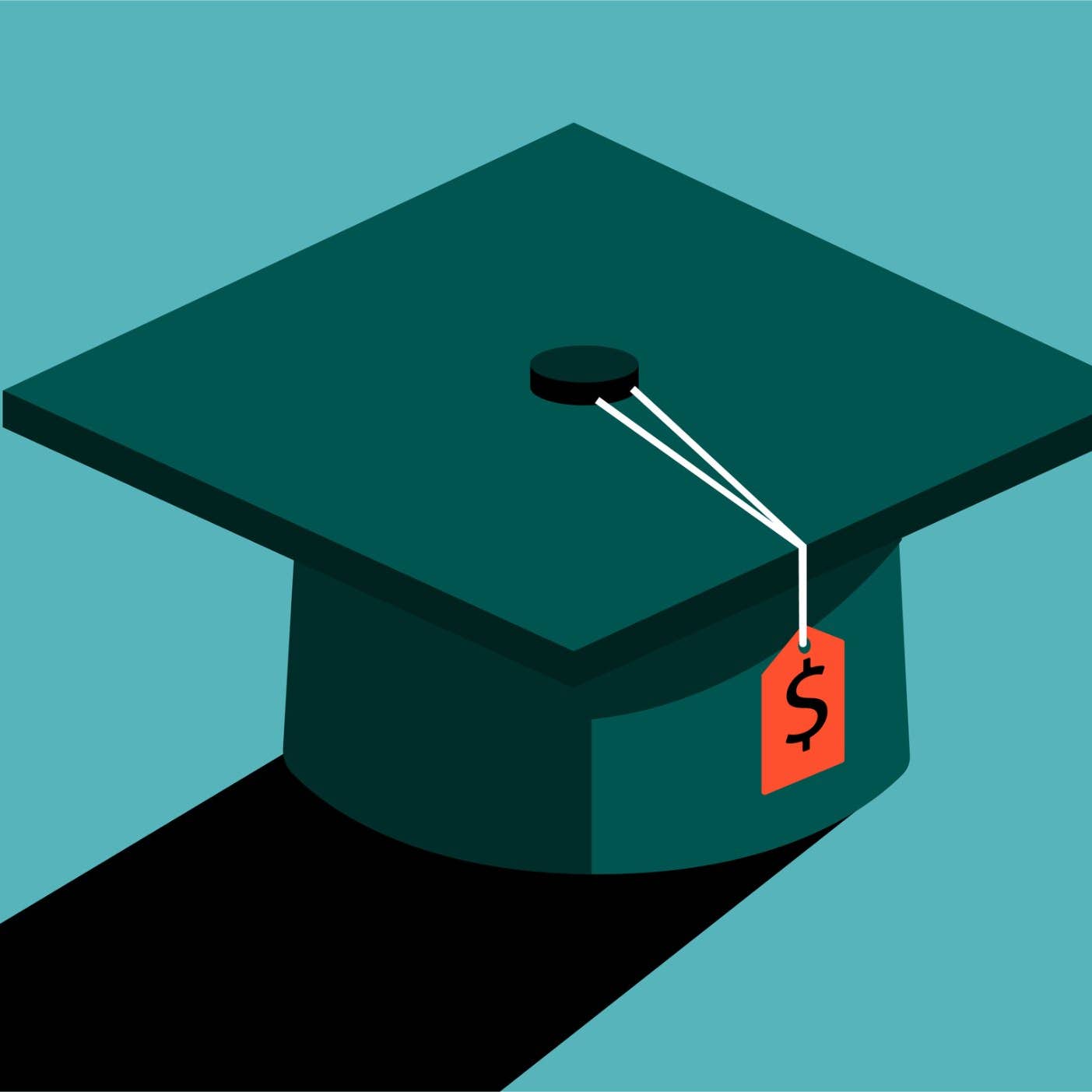Key takeaways
- It’s important to note that you can’t refinance federal loans without replacing them with a private loan.
- Researching different student loan repayment options is the most important step when refinancing private student loans.
- If you’re refinancing both federal and private student loans, you’ll need to add a few extra steps to the process.
If you have multiple student loans, you may be wondering how you can refinance them into one new loan, preferably at a lower rate and payment. One important thing to know before you get started: refinancing is only possible if you’re taking out a new private student loan.
There is no federal student loan refinance program that allows you to replace a current federal student loan. Although private loan rates may be significantly lower than federal rates, they don’t have the same hardship flexibilities as federal loans.
It’s important to take the necessary steps to not only find the best student loan refinance product for your goals but to determine which student loans are worth refinancing based on your finances.
5 Steps to refinancing your student loans
Before submitting a loan application, there are a few things you need to do to find the best offer:
1. Determine if student loan refinancing is the best option
Refinancing a student loan typically only makes sense if you have excellent credit and stable income to qualify for the lowest available private student loan rates. Review the types of loans you currently have, your remaining loan terms, current interest rates and monthly payments to see if you’d truly benefit from a refinance. If you have a mix of private and federal loans, decide whether you want to pay them all off, or just refinance the private loans.
Keep in mind:
Refinancing your federal student loans with a private loan means losing forbearance, income-based repayment options and other protections only offered with federal student loans.
Start by seeing if you qualify. You typically need a FICO score of at least 670 to get the best private loan rates. Check your credit scores and credit reports to determine where you stand. If your scores are low, improve your credit before you try to refinance: pay off credit card balances first and avoid new credit inquiries.
It’s equally important to consider which student loans to refinance and which you should leave alone. Start by reviewing the pros and cons of student loan refinancing.
Student loan calculator
Want to compare your current loan terms with new loan terms you’re considering? Bankrate’s student loan calculator is here to help.
Compare loan terms now
Asking the expert: Is refinancing the best strategy?
Bankrate principal writer and student loan counselor Andrew Pentis suggests that refinancing is best if you prefer a fast payoff.
Student loan refinancing can be a good option if you’re pursuing an aggressive approach to repayment, to pay as little interest as possible and to zero your balance ahead of schedule. This fast track to repayment can give you the feeling that you’re in control and on pace to achieve peace of mind.
— Andrew Pentis, Bankrate principal writer
It’s also important to weigh when a slower approach might make more sense. “If you have federal loans and earn a modest income, for example, you might rely on government protections, including the option to keep your monthly payments low and pursue long-term forgiveness,” Pentis said.
2. Research lender
Consider the following when researching lenders
- Whether the interest rate you are quoted is fixed or variable
- What the qualification requirements are
- If the lender allows cosigners to help boost your approval odds
- If the lender offers bonuses or incentives
- What payment options are available, and if they work for your finances
- If flexible due dates and skip-a-payment perks are available
- How the fees assessed by the lender stack up to the competition
- What reviews say about a borrower’s experience with the lender
If you decide to refinance your student loans, the next step is to compile a list of lenders that have products and programs that work best for you. You can start by reviewing lenders on marketplace sites like Bankrate. These lender rate pages allow you to view rates, discounts, qualifying requirements and expertly-vetted ratings of multiple lenders on the same page before you apply.
If you decide to shop on your own, review at least three different types of private lenders, like banks, credit unions and online lenders, to see what they might offer. The following are a list of lenders you may consider:
- Earnest: Earnest is one of only a few private lenders with hardship options that rival federal student loans, including a 30-year extended repayment term. Other benefits include autopay discounts and the ability to skip a payment without penalties.
- Citizens Bank: Eligible borrowers may qualify for much higher loan balances to refinance up to $750,000 worth of current student loans with terms as long as 20 years. And those who have another Citizens account, such as a checking or savings account, will receive a 0.25 percent rate discount.
- SoFi: In April 2025, SoFi announced a new repayment option for its 7-, 10-, 15- and 20-year refinance loans. It includes a nine-month interest-only payment, giving students who may be moving or starting new jobs a lower initial payment period.

Federal student loan changes making you eye private lenders? Here are 7 with federal loan-like perks
Wondering if private student loans might be a better fit? These private lenders offer some federal benefits.
Learn more
Be vigilant about the lender’s customer service during your research
It might be easy to overlook this step if your focus is on getting the lowest rate or payment, but Pentis explains why it’s important to consider how you’re treated before you apply for the loan. “If they helpfully field all of your questions and concerns when you’re applying for refinancing, they’re a stronger bet to be responsive once you’ve signed on the dotted line,” he says.
But he warns the opposite is true too.
If a refinancing lender offers attractive terms but isn’t helpful when you’re weighing your options, don’t expect their service to suddenly improve after you become a customer.
— Andrew Pentis, Bankrate principal writer
3. Shop for the best student loan option for your credit and income
Private student loans are fully qualifying loans, which means the terms you’re offered depend on your credit scores and income. That’s different from federal student loans, which don’t typically require a minimum credit score or proof of income for approval.
Your rate will likely vary between just below 4 percent to the low double-digits based on your credit history, debt-to-income ratio, the repayment term you select, and whether you choose a fixed or variable interest rate. Private student loan lenders may set minimum credit and income requirements, so make sure you choose lenders that fit your profile.
Prequalify with at least three lenders on your shortlist. The prequalification process typically only requires a soft credit inquiry on your credit report, and you can see the rates and loan terms you might qualify for if you refinance.

This defaulted private student loan borrower refinanced to a 1.8% interest rate. Here’s how she did it
Caitlin Cipriano couldn’t afford the monthly payments on her student loan debt, but a refinance lender gave her unconventional advice that helped her refinance her debt at a rate below 2 percent.
Learn more
4. Submit a loan application
Once you decide on a lender and loan offer, you’ll need to submit a full application, so the lender can finalize your loan approval and offer. This step usually includes providing information and supporting documentation about your current loans, graduation date, employment and earnings.
The lender will likely run a hard credit inquiry to review your full credit report and confirm your credit score. You may hear back about your approval within one to three business days, though it may take longer if you have a complicated income (commissioned or self-employed).
Documents and information you may need
- Social Security number (SSN)
- Driver’s license or government ID
- Loan payoff statements from existing student loan lenders or servicers
- Proof of graduation
- Proof of employment (pay stubs, W-2, etc.)
5. Transfer payments to your new lender
Once your student loan refinance is complete and the debt has been transferred, you should receive a payoff letter from your old lender. You will need to create an account with your new loan servicing company and begin making payments on your refinanced loan.
Keep an eye out for correspondence from the new lender identifying your first bill due date. Many lenders let you choose a date each month that works best for your schedule and budget, and some will offer a discounted rate if you enroll in autopay.
Bankrate’s take:
Don’t stop making regular payments on your current student loan being refinanced until you receive written notice the balance is zero. You’re still responsible for any payments until the refinance is completed. It’s easier to get a refund for overpaying than dealing with a ding on your credit report.
Frequently asked questions
Why we ask for feedback
Your feedback helps us improve our content and services. It takes less than a minute to
complete.
Your responses are anonymous and will only be used for improving our website.
Help us improve our content
Read the full article here












